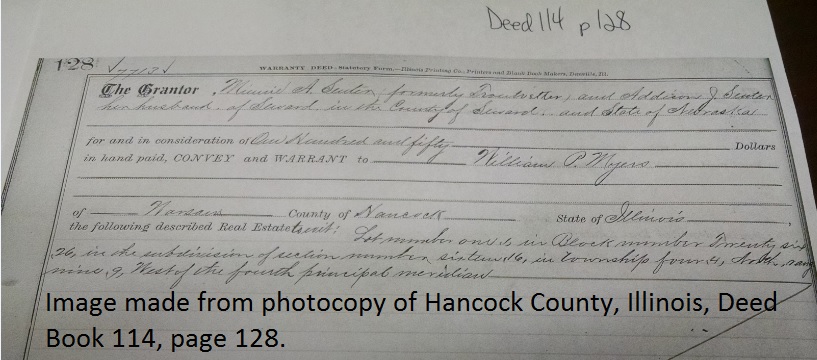In “Deciding not to follow up at the Family History Library,” an 1876 Illinois deed from a married couple to their apparent child was located at the Family History Library. The deed did not state the relationship between the grantors and the grantee (although all of them having the last name of Troutfetter makes a relationship rather obvious).
For reasons given in the original post, it was decided that time at the Family History Library would not well spent in looking for the deed where the original grantee (Minnie A. Troutfetter) transfers the land from her ownership.
That deed was located in very short order in the Hancock County, Illinois, courthouse using the “tract index” to land records, in this case the index to town lots.
The original 1876 deed contained the legal description of the property being sold and, using that description, the tract index made location of the deed where Minnie sold the property easy to locate. The tract index indexes land transactions based upon the location of the property, which was:
lot 1 in block 26 of the subdivision of section 16 in township 4-9 in Hancock County, County, located in the City of Warsaw.
The index referenced every land record impacting this lot. The deed of transfer right after the Troutfetter sale was one from Minnie A. Senter. At this point, there’s no guarantee that she’s Minnie A. Troutfetter, but the same first name coupled with Minnie A. Troutfetter acquiring the property and Minnie A. Senter selling it makes for a strong case. Without her last name as grantor, I would have been unable to find the deed. That’s why the tract index was so helpful.
Minnie A. Senter is styled on the deed as “Minnie A. Senter (formerly Trautvetter).”
That pretty much seals the deal.
There is an Addison J. Senter listed on the deed as well. It would be reasonable to conclude that he is her husband, even though the deed does not state it.
There’s a couple of other interesting items about this deed that we’ll discuss in a future post.
Neither of which have anything to do with why the United States Postal Service was watching her mail in the 1895-1905 era. That’s another story entirely.


No responses yet